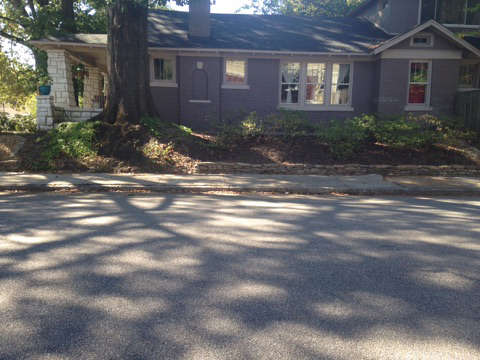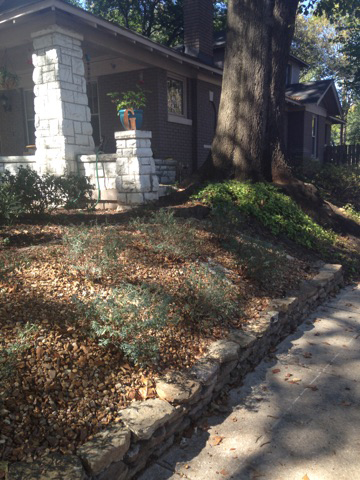 By Sharron Johnson
By Sharron Johnson
Have you ever driven down a street that you’ve been down thousands of times before and notice that something is different? We all have. But every once in awhile you drive past that same spot, and you are taken aback: Whoa! What is different? That jungle is gone from that corner. Holy cow!! Look at that new design/layout!
I drive the streets of Cooper-Young looking for the right garden to feature on a weekly basis, all the time thinking to myself, “this garden would be perfect for a spring or summer feature because of the colorful blooms, flowering trees and what have you.”
Fall and winter is another animal though. The gardens during those seasons are all about changes of foliage and the bones of the garden. The bones — or the hardscape — encompasses decks, paving, gravel, retaining walls, etc. The next layer of bones are the shrubs, deciduous or evergreens, and trees. Then the lace curtains, so to speak, of the garden are the flowering or nonflowering perennials and annuals.
The fall is when the garden is preparing for a winter nap. When everything has died back and the last of the leaves have been removed is the prime time to plan for the spring season and reevaluate issues and celebrate victories the garden had to offer. Is erosion or water a nemesis? Is there a lack of sun or too much cooking everything to a crisp? These are reasons why a gardener would need to make changes. Hardscaping the garden is probably the first project a new gardener should think about because it gives the gardener time to develop plant skills while enjoying a garden space. It will keep the gardener from wasting money on plants that will suffer or die, thus frustrating them from moving forward. Remember that Rome wasn’t built in a day.
I had a “whoa” moment early this summer Early this summer on the northwest corner of Oliver at Barksdale. One would never have noticed this corner before, but now it’s a grand entrance to that block of Oliver. The credit goes to Carlos and Stephanie Gonzalez. They are the proud owners of 1902 Oliver. It is a south facing property that receives some full sun at the street but then has dappled light from the sidewalk and back to the alley behind this well-appointed craftsman bungalow.
The stucco is painted a putty color with white trim that complements the white stone porch columns. The entrance to the property is directly on the corner. The concrete steps lead you into a new, well-designed garden that allows the visitor to enjoy the variety of hardscape the owners have incorporated, such as washed brown gravel used on the hilly parameters under plants used as mulch. Washed concrete where the pebbles are exposed creates a path to the front porch entrance and Arkansas field stone that create a cascade of steps on the opposite side of the front yard. There are two massive oak trees that are probably at least 94 years old due to the house being built in 1922.
“One is a water oak, and the other is a mutated version of a red oak and a water oak,” says to Judy Shellabarger, CY’s very own urban forest advisor.
The two trees guard the east of the garden like gargoyles and cast a shade over the entire yard. The trees have been allowed to define the garden and home. The stone front porch was dismantled and moved about three foot inward to accommodate the root spread of one of the Oaks at one time.
Beyond the oak at Barksdale’s edge, there are mature azaleas filling in the yard to the board fence that surrounds the back yard. The oak on the front of the garden is under planted with miniature monkey grass, more azaleas, and mountain laurel. A washed concrete path divides the curved planting area, where hydrangea and St. John’s wort mingle at the sidewalk’s edge and are mulched with brown stones. Then the stone steps lead to another planting bed lined with coral bells and more mountain laurel. A hardwood mulch grounds this area. A pair of hollies flank the wide porch steps like bookends. The entire garden is edged in Arkansas fieldstone. This delightful garden will be one of the 100-plus gardens in next year’s Cooper Young Garden Walk.
Tell us about where you two grew up and how you two met.
Stephanie Gonzalez: My father was in the military, so although I was born in Massachusetts, I grew up on Air Force bases in the U.S. and in Europe. After his second tour, when I was 9, my dad retired from the military, and we moved to Memphis. His stepfather worked at FedEx, and we’d loved the Memphis area when we came to visit. We settled in Collierville, where I graduated from high school. I graduated from the University of Memphis with a degree in journalism and lived in Midtown during college and for a couple years after, before the travel bug bit me and I wound up in Boston. Carlos grew up in Minnesota and Michigan and graduated from the University of Miami. A lifelong musician, he followed a bandmate up to Boston. The two of us met as friends there in 2007 through the music community. It wasn’t until 2010 that the fireworks set off, and we’ve been together since.”
How long have you two been married; big wedding?
We just got married in December 2015. We eloped to Puerto Rico and were married on the ruins of a beach light castle, just the two of us, an officiant, and a photographer. After we spent about 10 days driving, hiking and swimming all over the island. It was incredibly romantic and perfectly us — not a lot of fuss over details, just enjoying the experience and each other.
What brought you two to Cooper Young?
We left Boston for Austin in 2011 and were down there for about four years. When my youngest brother was planning his wedding for March 2015, I kept having to come back up to Memphis and was just having a blast with my family, who all live here, and couldn’t believe how much Midtown had changed in the decade I’d been gone. I was one of those folks who never thought I’d live in Memphis again when I left and now found myself just loving the city and wanting to be back. I did see how quickly Cooper Young houses were increasing in value, and Carlos and I decided that if we were going to move to Memphis, it’d be to CY. and that we’d buy a house. That was in February 2015. We started looking at houses while still living in Austin and made one trip up together to look. We made an offer on one that (thankfully) fell through in March. In April, I came up alone and found our home. We decided to act fast. We moved from Austin, making the 10-hour drive in one day and closed the following day, May 1, 2015. It was the first time Carlos had seen the house. Luckily, he loved it, or I might have been in big trouble!
Why did y’all pick this house?
We knew we wanted an old house with a lot of character. Carlos has experience doing historical renovations, so we figured it was something we could handle. We kept seeing these adorable old houses that had been renovated in just horrendous ways; cheap renovation jobs on the kitchens, for example. We wanted something that had the major stuff, like HVAC, updated, but that cosmetically was fairly untouched. And that’s one of the reasons we love this house. The original character hasn’t been covered up. That’s certainly not to say it was in great condition, but we were both excited about restoring it to its former glory and caring for it in a way that it seemed it hadn’t been in years. We own a piece of history and are respectful of that fact.
What are y’all’s occupations?
I am the director of marketing for a start-up based in Colorado called TeamSnap. We make an app that youth sports coaches use to manage their team’s roster, schedule, and communication. Based on over a decade of experience working in the home renovation and restoration industries and a love of historic properties, Carlos started his home inspection business, 901 Home Inspection, early this year. He does pre-sale inspections but also inspects homes for current owners, just to give them an idea of what’s going on with the 100-year-old house they may not have had inspected in 25 years. He’s also a working musician, and you might see him around town playing Central BBQ, Tamp and Tap, and a variety of other places.
What was the garden like when you moved in?
We’re on a corner lot and the sidewalk was completely overgrown with weeds. You could barely get by. One side of the front yard was overgrown with poison ivy. The whole thing was just trashed, literally and figuratively. Erosion had caused major damage on the sloped sides of the yard and we kept finding Matchbox cars absolutely everywhere we dug. We must have come up with a collection of 20. What seemed like years of leaves from the old oaks were covering everything, creating quite the bug farm underneath, and there were a dozen very overgrown azaleas in the front that had just turned into kind of a bramble. And that was just the front … In the backyard, everything was so overgrown that we didn’t know until we started cleaning up that we had the foundation for an old garage out by the alley. We also uncovered an old punching bag that had been out there so long it had actually mostly decomposed, as well as the bones of an above-ground pool. We had enough garbage to start our own landfill. The first couple of months, we were putting out about 10 bags of yard waste a week. It was a serious undertaking to get it even cleaned up.
I remember this house and garden as being overgrown. You cleared out mature bushes and added a planned, well-thought-out landscape design. Why?
It was very overgrown. There were about a dozen azaleas in the front that had been planted too closely together when they were younger. We wanted to keep those beautiful mature plants though, so we actually just moved half of them over to the Barksdale side of the lot and spread them all out. They’re now filling in nicely, and we’re grateful that we could keep the plants that our neighbors said a former owner from years ago used to keep looking lovely. The real impetus for our landscaping overhaul was water drainage. We had water pooling at the foundation and coming into the basement. In fixing those issues, we did a lot of hardscaping and figured we might as well go all out and just reconfigure the whole lot.
Is there a bit of advice you wish you would had before conquering a older garden?
One piece of advice we got about the house as a whole when we moved in was, “It’s an old place. Don’t try to do everything at once.” We fought a lot of urges to just act immediately and followed that advice. We sat on the lot for about a year before taking any action, and I think that was a really good idea. We got to see what happened in every season, where water pooled and where problem areas were, and also think about what we wanted. I think the biggest thing is just working with the lot you have instead of against it. Our very sloped, very shady lot is not conducive to a lush green lawn, so we didn’t go in that direction.
Your landscape is low maintenance, I’m sure that’s by design?
Absolutely. I really do wish I were someone who found peace of mind by getting out in the garden and digging and planting and moving. Carlos enjoys it more than I do, but between running his own business and also being a working musician, it can be hard to find the time. And when we do have extra time, we want to be enjoying our neighborhood and our city. The biggest thing was just not wanting to feel like there was something to constantly “stay on top of,” while being able to have a yard worthy of a corner lot in a charming neighborhood. I think we found a really nice balance.
Tell the reader some of the victories and pitfalls you’ve encountered.
That first summer after we moved in when we were getting the yard cleaned up was just brutal. I got a whole band of poison ivy from the yard all across my stomach. I was itching for weeks. And Carlos just about broke his back clearing the lot. I will say though, that was a complete labor of love and one of the reasons why was because we’d be out cleaning things up, filthy and sweaty, and our amazing neighbors would pull over in their cars or stop as they were walking by to tell us how amazing it looked and how much they appreciated someone taking care with the yard. That community feel was exactly what we were looking for in a neighborhood, and it just made us feel really good.
Are you two new to gardening?
I most certainly am. Carlos used to work as a landscaper in Boston, so although he’s not new to gardening, this is a new zone to him. That’s another reason the low-maintenance really works well for us.
What are some of your future plans for the front and back of the property?
We’re thinking of adding some bulbs and maybe wildflowers in the front. That’ll keep the low maintenance theme but will add some extra color, and we do love the wild look those sorts of plants can bring. In the back, we’re really still in the process of getting the yard down to its bones to find out what we want to do. We’ve finally got all the trees trimmed and a lot of the extra overgrowth cleared (we don’t want to clear it all because we love the haven for birds it creates back there). Eventually, we’ve talked about putting in a raised vegetable garden, maybe some wildflower beds and a deck. Just like the front, we want it to be a place we can just sit back and enjoy.
There are two oak trees that appear to be close to 100 years old. Were they a determining factor of the selecting of this house?
Absolutely. Even with the overgrown lot, I felt a huge attraction to the two beautiful oak trees and the corner-lot path leading to a quintessential Midtown front porch. We love just sitting out on that front porch under the shade of the oak trees waving to our neighbors. Even my step dad, who lives on a lake out in Mississippi, talks about how much he loves sitting under those trees. Their appeal is just unmistakable, and, like with the house, we’re honored to be their caretakers.
What was the inspiration for the design, layout and plant selection?
As far as inspiration goes, we really went for function first. We wanted to give the yard good structure without it looking overly manicured. So, for example, we had to do something about the erosion and wanted to put in some sort of a retaining wall but went with simple stacked natural stone rather than something more formal like brick. For plant selection, we really just wanted to keep it simple and obviously go with what worked for the shady, sloped lawn. I did want color though when we do have blooms, so we have the white gardenias, blue hydrangeas, yellow St. John’s wort and pink and white azaleas.


